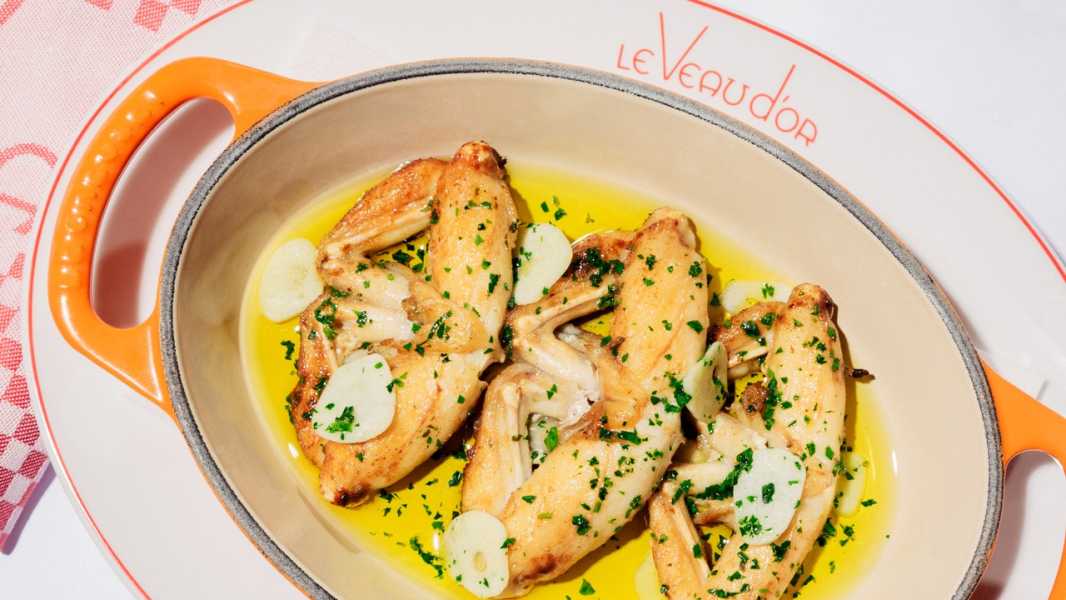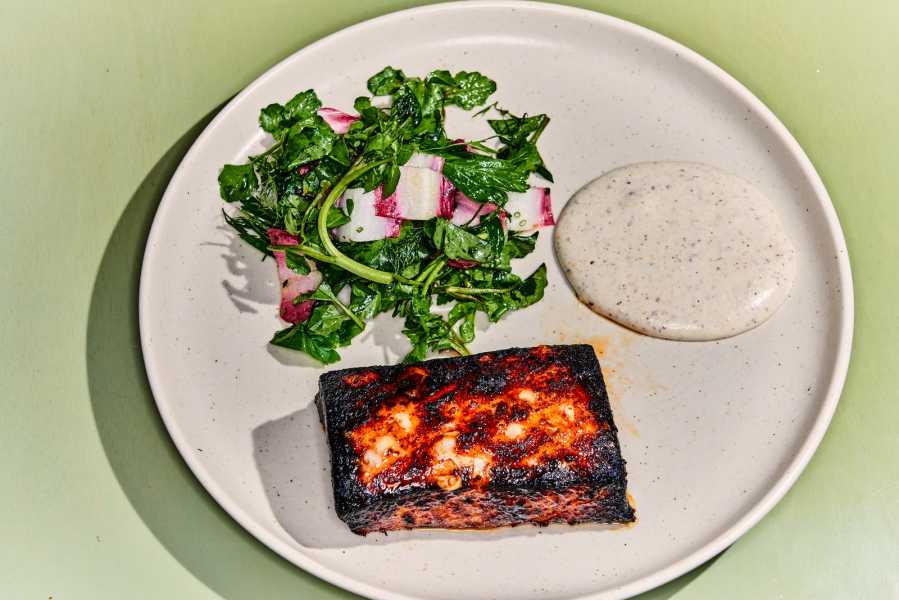
Save this storySave this storySave this storySave this storyYou’re reading the Food Scene newsletter, Helen Rosner’s guide to what, where, and how to eat. Sign up to receive it in your in-box.
Those of us in the admittedly absurd position of eating for a living come to learn, after some time on the job, that, on balance, most food tends to be pretty good. Of the hundreds of restaurant dishes I’ve had in the past twelve months, the vast majority were quite enjoyable, a portion were forgettably pleasant, and fewer than a dozen rated as actually bad. But only a small selection were terrific in a revelatory way, offering moments of exceptional sensory surprise or sheer experiential pleasure. Not all of the dishes on this list come from restaurants that I had the chance to review, though all are from new spots, and not all of the restaurants might make my Best Restaurants of the Year list, were such a thing to exist. But that’s the beauty of thinking about a year in dishes, rather than in meals: there’s a certain clarity in a plate of food taken simply as a plate of food, divorced from such hand-wavy factors as vibe or mood or service. What’s good to eat has the freedom to be just straight-up good. The dishes here range from the special occasion (an ultra-high-end pasta punched up with foie gras) to the everyday (a grab-and-go sandwich I’ve had for lunch half a dozen times in recent months). Happiness—at least, of the gustatory kind—comes in all forms, and at all price points.
Grilled Cheese at Cocina Consuelo
Nearly everything on the menu at this colorful, pocket-size Hamilton Heights restaurant is a little bit of a revelation. (I’d considered myself a bone-marrow skeptic, and yet the chef Karina Garcia’s birria-topped version got me believing.) But there’s a special ingeniousness to the grilled cheese on the restaurant’s breakfast-and-lunch menu. It consists of a golden, fresh croissant, split in half, layered with sharp cheddar and smeared with spicy, smoky, crunchy salsa macha, and then griddled into something crispy, chewy, butter-slick and resoundingly savory. It’s a brash, brilliant addition to the city’s pantheon of unmissable sandwiches. Full review »
Frogs’ Legs Persillade at Le Veau d’Or
Of all the old-school French classics that the marvellously reinvented Le Veau d’Or has rescued from unfashionable stodginess, the most thrilling has got to be the frogs’ legs. They arrive in a searing-hot butter bath, out of which bloom the aromas of sharp garlic and fresh parsley. A tableside squeeze of lemon juice kicks the whole thing up into a zingy, sizzling party. The legs, reclining elegantly in their enamelled cocotte, are best eaten with your hands, nibbled off the bone like ritzy chicken wings. Use the restaurant’s excellent bread to sop up all the butter and its aromatics. Full review »
Jambon-Beurre at Cafe Mado
I was put into a mild funk earlier this year by the news that Oxalis, the chef Nico Russell’s Michelin-starred restaurant on the edge of Prospect Heights and Crown Heights, was closing, and was then snapped out of it by the promise of its replacement, also from Russell: Cafe Mado, an all-day spot with sit-down dinner service and a more loosey-goosey daytime vibe. Russell and his team are terrific at creating an atmosphere of easy sophistication (Place des Fêtes, their Clinton Hill restaurant, is simply heaven), and Cafe Mado’s dinner is cheffy and smart and delicious—but it’s the daytime menu that really has my heart, especially a rendition of the jambon-beurre sandwich. Jambon-beurre is one of those classic French dishes of a deceptive simplicity; its success depends entirely on the superlativeness of its ingredients. Cafe Mado’s features tender, thin-sliced ham, salty butter, and a fresh baguette (made daily at Brooklyn Heights’ Laurel Bakery, part of the same restaurant family) that’s ideal in both crispness and yielding chew. To this holy trinité of elements, Cafe Mado adds slivers of intense aged Comté, glitteringly sharp, almost spicy. It’s note-perfect.
Duck-Duck-Duck Tortellini at Café Carmellini
This dish’s clever name is a reference to the triple whammy of waterfowl with which it’s made: a duck farce that fills the pillowy pasta envelopes, a rich jus that glazes them, and a savory foam that tops them. Foam is back, baby, whether we like it or not, though here it actually serves a purpose, lightening up what could have been the overwhelming richness of brandy and foie gras. It’s a nice little metaphor, too: Café Carmellini is a temple to European gastronomic grandeur, with tailored-service captains and fancy silverware, but it manages to also be a surprisingly fun restaurant, never tipping over into gilded-age absurdities, just fussy enough to seem in on the joke of its own fussiness. Full review »
Khao Khai Ra-Bert at Sukh
This stylish Fort Greene spot, modelled to look like the interior of a vintage train car, is among the latest in a slew of fantastic Thai restaurants that have recently been reshaping the city’s understanding of Southeast Asian food. I haven’t had a single unexciting dish here, but the one I love most is a take on khao khai ra-bert, a popular street food in Surat Thani, the southern Thai home town of Sukh’s co-owner Kiattisak Auyyamathiti. A burnished, cloudlike fried omelet sits on top of a hillock of white rice, buried beneath a portion of ground beef cooked khua-kling style (in a dry curry with tart notes of lemongrass and makrut lime). The result is a carnival of flavor and texture—the soft airiness of the egg, the slick-dry crumble confetti of the meat, the searing flame of chile-pepper heat, the welcome relief of the crunchy cucumber wedges that come alongside. My first experience of this dish was in the restaurant, and I’ve been back plenty of times, but I won’t pretend I didn’t rejoice when I realized that I lived within Sukh’s delivery radius. On days when I just can’t bear to leave the house for yet another restaurant meal, this is one of my most reliable, most unceasingly happy-making order-ins.
Helen, Help Me!
E-mail your questions about dining, eating, and anything food-related, and Helen may respond in a future newsletter.
Bagna Cauda at Borgo
I have yet to encounter a version of this Piedmontese sauce by which I’m not entirely enraptured—who wouldn’t love a slippery, warm dip of garlic, anchovy, and olive oil, meant for dipping raw seasonal vegetables? The version at Andrew Tarlow’s new Manhattan restaurant Borgo cleverly turns halved radishes and turnips into their own vessels: each face is carved with a little divot into which ideally portioned doses of the sauce has been poured. When you crunch down on one, the oily, savory pool seems to burst in your mouth, rich and full-bodied and (maybe it’s the ambient effect of the kitchen’s open-flame oven) just a little bit smoky. The dish is a delight to look at, a delight to consume. Full review »
Fall Chicory Salad at Crane Club
The sprawling, stately West Chelsea space that used to be Al Coro, and before that Del Posto, was recently reborn, yet again—this time, under the night-clubby aegis of the Tao Group, who’ve turned it into a steak house. It’s reassuring, and also a little curious, that the chef Melissa Rodriguez, who was Del Posto’s final executive chef and then ran Al Coro from the same kitchen, remains at the helm. This means that, regardless of how you might feel about mega-clubstaurant steak houses, Crane Club offers a few pleasing elements of continuity with the kitchens that have come before it. Most notable among them is an earthy, curvaceous, truffle-infused vinaigrette similar to a version at Del Posto that was drizzled over bitter greens. At Crane Club, the dressing coats a multicolored pile of chicories that seemed to be given a bit of a Middle Eastern edge with lots of big, sharply green leaves of parsley and bits of tempura-fried vegetables that have the pleasing, structured yet mushy mouthfeel of the pieces of pita in a fattoush. The salad is vegetal and luxe and weird, a bright spot in an otherwise underlit room.
The Classic Smash Burger at Hamburger America
I don’t think I can improve much upon my original description of this excellent, compact, Boy Scout of a burger: “It’s a hamburger you trust, a hamburger you’d feel good about taking your daughter to prom.” Hamburger America is the first official restaurant from the burger obsessive George Motz, after his long tenure of pop-ups and master classes. It pairs a crisp-edged disk of fresh ground beef with melty cheese and a few rounds of pickle, along with a bit of onion and a zippy whip of yellow mustard. In the time since I reviewed the restaurant, nearly a year ago, I’ve had the pleasure of Classic Smash’s company more than a few times, and I remain entirely devoted to its simple, nostalgic perfection. Full review »

Photograph by Amy Lombard for The New Yorker
Surf Clam with Coconut Milk at Lai Rai
The downtown restaurant Mắm, which opened a couple years ago after a period as an itinerant pop-up, is one of my favorite warm-weather spots. Outside the tiny storefront, the sidewalk (and often a fair bit of the street) is crowded with diners perched on low plastic stools set around low plastic tables, gustily eating some of the best, most electrifying Vietnamese food in the city. As the weather become colder and wetter, I’ve become enamored of Lai Rai, a few doors down, operated by the Mắm team (in collaboration with the Greenpoint restaurant Đi Ăn Đi). Where Mắm is scrappy and exuberant, Lai Rai is quiet, self-contained, thoughtfully composed—it’s more a wine bar than a full restaurant, with a deep list of natural-production bottles, and a short, tight list of Vietnamese-inflected bar snacks. One of the loveliest moments of my year was spent gossiping with a friend at the marble bar, each of us sipping something minerally and white, pausing to eat slivers of an enormous surf clam, just barely cooked and chewy-tender, served in its shell under a creamy coconut broth drizzled with a bright-green oil made from shiso, basil, and spicy-floral rice paddy herb. The dish is subtle, gentle, and electrifying, all in one.
Blackened Swordfish Belly at Strange Delight
It’s been a big year for swordfish, which has surged back onto menus after years (decades?) in a purgatory of unforgivably retro ingredients. It appeared on the opening menu of the revived Central Park Boathouse, harkening back to its nineties heyday. It gets the straightforward steak-of-the-sea chophouse treatment at Time and Tide and the Otter. But the most revelatory version I’ve tried is at Brooklyn’s mega-charismatic new New Orleanian spot Strange Delight, where the chef Ham El-Waylly sidesteps the fish’s tendency toward blandness by serving it blackened, with spicy, peppery Creole seasoning, and avoids its tendency toward dryness by using the melty, fatty belly cut. The result is as buttery as black cod and as lascivious as lardo. Full review »

Photograph by Scott Semler for The New Yorker
Tuna Carpaccio at Penny; Tuna Tartare at the Otter
Tuna, too, has had a banner year, though unlike swordfish it never really went out of style. At Penny, the pert and polished East Village seafood bar, the ruby-fleshed fish is served as a carpaccio: laid out in large, thin, near-translucent petals and dressed simply, with a swizzle of olive oil, a few curls of white onion, and salty bits of supple green olives. The presentation is restrained and reverent, but the flavors play together with dynamically on the tongue. Full review »
At the Otter, the chef Alex Stupak’s latest restaurant, in Soho’s new Manner hotel, the fish gets a more classic tartare presentation, finely cut into tiny cubes, but it’s dressed in an punchy relish of anchovy, pickled peppers, and again—tuna’s new best friend?—green olives, inspired by the chic little Basque skewered tapa known as a gilda. It’s a little puttanesca, a little off-kilter, totally wild.
Kibbeh Nayeh at Sawa
Since my first bite of the chef Soroosh Golbabae’s version of this classic Levantine dish, served at the chic Park Slope Lebanese restaurant Sawa, I’ve been fixated on this dish. The texture of the raw lamb, minced to a smeary fineness, is lightened with bulgur, and its mildly gamy flavor is warmed and sharpened with nutmeg and salt. It’s served doused in a vivid-hued, sumac-infused Lebanese olive oil, slick and peppery, with aromatic curls of green onion and fresh mint leaves. Somewhat nontraditionally, instead of being served with soft pita, it’s accompanied by crackly pita chips, made fresh from the bread baked in the restaurant’s cheerful tiled oven, which fills the establishment with its yeasty aromas. Full review »
French Fries at Jean’s
I was pretty sure I’d never set foot in Jean’s, a sizzling NoHo clubstaurant with an unabashedly eighties-glam dining room, where even the red velvet is printed with zebras. The place is beloved of the tanned and long-limbed TikTok, Bravo, and fashion-influencer sets, and I am but a blobby Brooklyn mom with streaks of gray in my hair. Still, I kept hearing how great the food was, often with the addendum “Especially for a place like that!” A backhanded compliment? A damning insult? What I saw on Instagram did look shockingly good: elegant bistro-ish fare, plated with care and respect, plus pile after pile of incredibly gorgeous-looking french fries, thin and glittery as the restaurant’s clientele, glowing golden even in the restaurant’s red-tinged lighting. I finally went in for a meal—it was really good, especially for a place like that!—and the fries lived up to the hype, and then some. Jaunty, crisp, hot, salty, they’re like McDonald’s fries but somehow even better, which in my book is the greatest compliment any french fry can hope for. ♦
Sourse: newyorker.com






